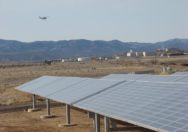
Last week the South Dakota Public Utilities unanimously approved a 19 per cent reduction in pay for renewables – that is the generation credit rate Black Hills Energy pays to small renewable energy producers. This is a kick in the teeth to all who invested in renweable energy thinking they could forecast the payback time and the hit on their own personal finances.
The generation credit rate will be set to 2.75 cents per kilowatt-hour, from the current rate on 3.32 cents.
The commissionion says it may also wants to set generation credit rates differently for the kinds of fuel used to create it – so coal will get less and solar will get more.s. The decision to base the credits by sources will come no later than 2019.
“Black Hills Energy should broaden its electricity sources. About 90 per cent comes from burning coal”, he says.
Nelson praises Richard Bell, an engineer and customer of Black Hills Energy, for bringing the concept to the commission. Bell is one of 35 small producers who receive credits on their electricity bills for the electricity they supply to the company.
Small producers might drop out
However, due to the credit reduction, Bell is worried that small producers will drop out, and explains that many people are going to go off the grid if they are going to be compensated at such a low rate.
The commission voted 3-0 to accept the Rapid City company´s proposal. The reduction will take place on June 1st.
Not happy with Black Hills Energy´s deal
Joining Bell at the witness table was Jay Davis, a Rapid City lawyer who has a renewable-energy system on his house and receives generation credits from the company. He invested roughly $11.000 to install the panels and received a 30 per cent federal credit.
“We wanted to set a good example for the rest of the community, a positive and forward looking example”, he says.
Davis is not pleased with the deal he is getting from Black Hills Energy at the moment. He explains that he pays 9.98 cents per kilowatt-hour for electricity at his house, but gets 3.32 cents credit for the electricity produced by the solar system on his house. Worse, he says, the company charges him $9.25 monthly because he is a customer and another $12.99 per month in cost adjustments.
Manager sees no reduction of coal in near future
Lisa Seaman, Black Hills Energy´s manager of resource planning says she does not see the company reducing their dependence on coal very much.
“Not in the near term”, she states. “Right now the utility has enough electricity without the 35 to meet the needs of customers”.
Nelson sees Seaman´s point, but says the company needs to start taking the small producers into consideration in the future. South Dakota’s voluntary goal by utilities is 10 percent for renewables. Black Hills Energy is at 0.17 percent at the moment.
The U.S. among the top countries in electricity generated by the sun
The United States is among the top countries in the world in electricity generated by the sun and several of the world´s largest utility-scale installations are located in the desert Southwest.
The Ivanpah Solar Electric Generating System is a solar thermal power project in the California Mojave Desert. It delivers power to PG&E and Southern California Edison. The project is currently the largest solar thermal power plant in the world, according to Bright Source Energy.
The website also stated that the electricity generated by the plants is enough to serve more than 140.000 homes in California during the peak hours of the day, and the complex will reduce carbon dioxide (CO2) emissions by more than 400.000 tons per year.
Governor Jerry Brown has signed legislation requiring California´s utilities to obtain 50 percent of their electricity form renewable energy sources by the end of 2030
